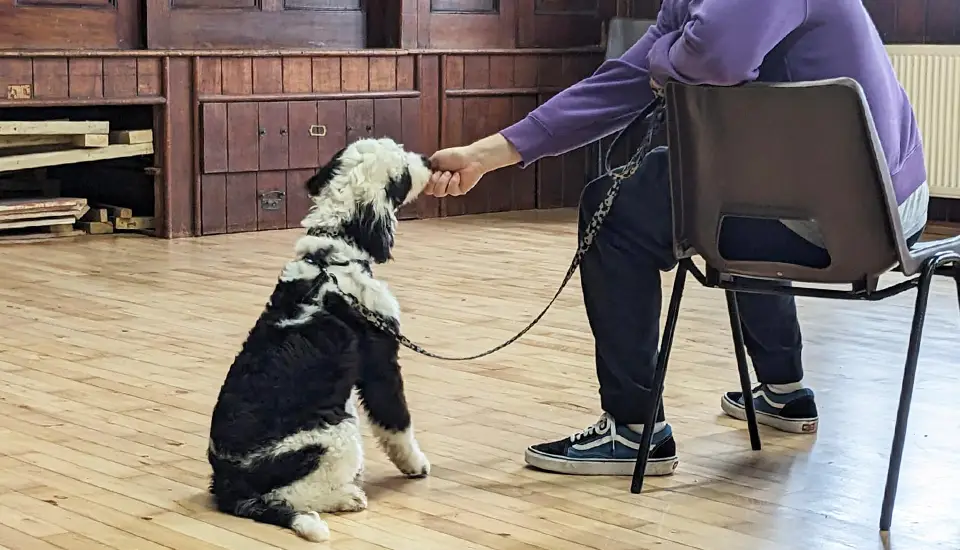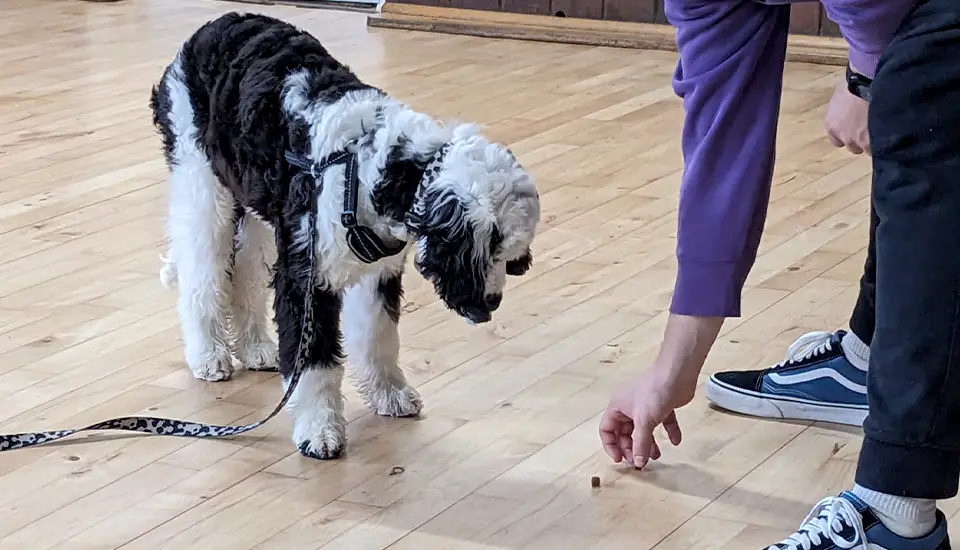Positive reinforcement training methods are the most ethical and effective way to train your puppy or dog. The idea is to focus on the things that you would like to see more of (desirable behaviours) and reward your dog for showing them. You can use treats, toys, verbal praise, or physical praise for this purpose, depending on which one your dog finds most rewarding.
Science proves that if your dog is rewarded for showing a certain behaviour, they are much more likely to show this again in the future, to access further rewards. Training your dog positively helps them to take in, understand and remember new information more effectively too, so it can really help to speed up your training.
Here’s a simple example to help you visualise what positive reinforcement training looks like:
Imagine that you want to teach your puppy to ‘Sit.’
If you were using positive reinforcement training methods, you could do this by luring your pup with a treat in front of their nose in an upward motion, while they are standing up.
This is likely to encourage them to move their bottom downwards into a sitting position.
When they are in this position, you mark this exact moment with a click (from a clicker) or a verbal marker word such as ‘Yes,’ and then follow this up with a tasty treat.
In doing so, this rewards your pup for showing a behaviour you would like to see more of and increases the likelihood of them replicating this behaviour again.

Why Should I Use Positive Reinforcement Methods With My Dog?
Here are 9 great reasons why you should use positive training methods with your puppy or dog:
- It helps to pair positive emotions and feelings with desirable behaviour,
- It increases the likelihood of your dog showing desirable behaviours frequently.
- It takes the focus away from unwanted behaviours by rewarding the more appropriate ones.
- It is enjoyable for both you and your dog to practice together and helps to strengthen the bond you share with each other.
- It can be used to teach your dog brand new behaviours, as well as changing existing undesirable behaviours for more desirable ones.
- It’s great for teaching more complex behaviours by breaking them down into simple steps for your dog. (This is known as shaping.)
- It sets your dog up for success, instead of waiting for them to fail.
- It helps your dog to understand exactly what they are being asked to do. Remember, our dogs are extremely intelligent, but humans often give them confusing and unclear instructions which can lead to frustration!
- It is not bribery; it is a way of clearly communicating to our dog how we would like them to behave.
Top Tips For Positive Reinforcement Training
There are some things you should consider so that you can get the most out of your positive reinforcement training. Here they are:
Consistency – Always make sure to follow up your click, or marker word, with a reward. This helps to create positive associations for your dog, and helps them to understand that making good choices always brings them good things as a result.
Reward Type – You need to make sure you choose your rewards to be something that your dog genuinely finds rewarding and reinforcing. For lots of dogs, this could be a high-value tasty treat, while others may prefer to play with their favourite toy. Every dog is individual, so the type of reward that works best for one dog may differ from another.
Frequency Of Reward – When your dog is learning a new behaviour that they have not come across before, it’s important to reward them every single time they show it. This really helps to reinforce this behaviour, and cement what we are looking for. Then, further down the line, when your dog reliably understands the behaviour, the rewards can be reduced gradually.
Level Of Distraction – You should start your training in locations which are not very distracting for your dog. For example, if you are trying to teach them a recall, they are not likely to be able to come back to you successfully if the first time you teach them is in a busy park with lots of other dogs around. So, set them up for success by starting in a very quiet area like your living room, where there are fewer distractions. You can build up the level of distractions gradually as your training progresses.
Practice Regularly – The saying goes that ‘practice makes perfect’ and this is true for your dog’s training. Positive reinforcement is fantastic, but your results will be even better if you practice regularly. It will soon become second nature to you to focus on the behaviours you want to see more of and rewarding your dog for them.
What To Do Next?
As you can see, the benefits of positive dog training are limitless, and this is exactly why I use these methods with my own dogs, and with my client’s dogs. So, if you would like some help with teaching your dog using positive reinforcement, you can get in touch with me to book a place on my training courses here


